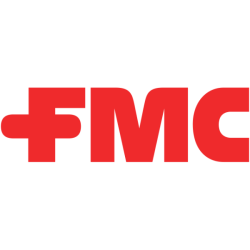FMC Corporation is positioned with a strong business model driven by a focus on core and growth portfolios, successful cost management, and a robust product pipeline. However, challenges in inventory management and increased competition from generics raise concerns about short-term performance. Looking ahead, there are promising growth opportunities linked to new products and market strategies, but the company may face pressures in the immediate future.
Analysis Date: February 4, 2025
Last Updated: March 12, 2025
Trailing Twelve Months (TTM) values provide a view of the company's performance over the last year.
Graham Value Metrics
Benjamin Graham's value investing approach focuses on finding stocks with a significant margin of safety between their intrinsic value and market price.
Intrinsic Value
Estimated fair value based on Graham's formula
$46.59
Current Market Price: $35.41
IV/P Ratio: 1.32x (>1.0 indicates undervalued)
Margin of Safety
Gap between intrinsic value and market price
24.0%
Graham recommended a minimum of 20-30% margin of safety
Higher values indicate a greater potential discount to fair value
ROE: 7.5898075274682455
ROA: -0.1398745419752345
Gross Profit Margin: 38.951037422576015
Net Profit Margin: 8.028543840229858
Trailing Twelve Months (TTM) values provide a view of the company's performance over the last year.
Strong Gross Profit Margin
38.95
Gross Profit Margin
FMC's gross profit margin of 38.95% indicates effective cost management and strong pricing power in its operations, which is a positive indicator of profitability.
Solid Operating Profit Margin
10.25
Operating Profit Margin
An operating profit margin of 10.25% demonstrates that FMC is able to retain a good portion of revenue after covering operational costs, reflecting efficient operations.
Modest Net Profit Margin
The net profit margin at 8.03% indicates that while FMC is profitable, its ability to convert sales into actual profit is relatively modest compared to competitors.
About Profitability Metrics
Profitability metrics measure a company's ability to generate earnings relative to its revenue, operating costs, and other relevant metrics. Higher values generally indicate better performance.
Return on Equity (ROE)
Measures how efficiently a company uses its equity to generate profits
7.59%
10%
15%
Higher values indicate better returns for shareholders
TTM (as of 2025-04-16)
Return on Assets (ROA)
Measures how efficiently a company uses its assets to generate profits
-0.14%
3%
7%
Higher values indicate better asset utilization
TTM (as of 2025-04-16)
Gross Profit Margin
Percentage of revenue retained after accounting for cost of goods sold
38.95%
20%
40%
Higher values indicate better efficiency in production
TTM (as of 2025-04-16)
Net Profit Margin
Percentage of revenue retained after accounting for all expenses
8.03%
8%
15%
Higher values indicate better overall profitability
TTM (as of 2025-04-16)
Strong Current and Quick Ratios
FMC's current ratio of 1.64 and quick ratio of 1.24 indicate that the company has a strong liquidity position, suggesting it can easily meet its short-term obligations.
Manageable Debt Levels
0.78
Debt-to-Equity Ratio
With a debt-to-equity ratio of 0.78, FMC has a balanced approach to leveraging, which suggests a stable financial structure without excessive reliance on debt.
Low Cash Ratio
The cash ratio of 0.12 indicates that FMC has limited cash available to cover current liabilities, which may pose a risk if immediate liquidity is required.
About Financial Health Metrics
Financial health metrics assess a company's ability to meet its financial obligations and its overall financial stability.
Debt to Equity Ratio
Total debt divided by total equity
0.78x
1.0x
2.0x
Lower values indicate less financial leverage and risk
Less than 1.0 is conservative, 1.0-2.0 is moderate, >2.0 indicates high risk
Q4 2024
Current Ratio
Current assets divided by current liabilities
1.64x
1.0x
2.0x
Higher values indicate better short-term liquidity
Less than 1.0 is concerning, 1.0-2.0 is adequate, greater than 2.0 is good
Q4 2024


